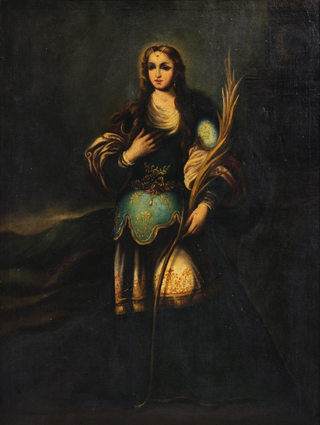
Agnes of Rome is a virgin martyr, venerated as a saint in the Catholic Church, Oriental Orthodox Church and the Eastern Orthodox Church, as well as the Anglican Communion and Lutheran Churches. She is one of several virgin martyrs commemorated by name in the Canon of the Mass.

Philomena, also known as Saint Philomena or Philomena of Rome was a virgin martyr whose remains were discovered on May 24–25, 1802, in the Catacomb of Priscilla. Three tiles enclosing the tomb bore an inscription, Pax Tecum Filumena, that was taken to indicate that her name was Filumena, the English form of which is Philomena. Philomena is the patron saint of infants, babies, and youth, and is known as "The Wonderworker".

Margaret, known as Margaret of Antioch in the West, and as Saint Marina the Great Martyr in the East, is celebrated as a saint on 20 July in Western Christianity, on 30th of July by the Eastern Orthodox Church, and on Epip 23 and Hathor 23 in the Coptic Orthodox Church.

Saints Faith, Hope, and Charity, are a group of Christian martyred saints who are venerated together with their mother, Sophia ("Wisdom").

Apr. 30 - Eastern Orthodox Church calendar - May 2.

May 30 - Eastern Orthodox Church calendar - June 1

July 31 - Eastern Orthodox liturgical calendar - Aug. 2

August 10 - Eastern Orthodox liturgical calendar - August 12

August 12 - Eastern Orthodox liturgical calendar - August 14

Sant'Agnese in Agone is a 17th-century Baroque church in Rome, Italy. It faces onto the Piazza Navona, one of the main urban spaces in the historic centre of the city and the site where the Early Christian Saint Agnes was martyred in the ancient Stadium of Domitian. Construction began in 1652 under the architects Girolamo Rainaldi and his son Carlo Rainaldi. After numerous quarrels, the other main architect involved was Francesco Borromini.

December 31 - Eastern Orthodox liturgical calendar - January 2

January 22 - Eastern Orthodox liturgical calendar - January 24

Eugenia of Rome was an early Christian Roman martyr whose feast day is celebrated on December 25 in the Roman Catholic Church, on December 24 in the Eastern Catholic Churches and Eastern Orthodox Church, and on January 23 in the Armenian Apostolic Church. She is included in the Golden Legend.

Martinian and Processus were Christian martyrs of ancient Rome. Neither the years they lived nor the circumstances of their deaths are known. They are currently buried in St. Peter's Basilica in Rome.

Mark and Marcellian are martyrs venerated as saints by the Roman Catholic Church and the Eastern Orthodox Church. Their cult is sometimes associated with that of Saints Tranquillinus, Martia, Nicostratus, Zoe, Castulus, and Tiburtius, though not in the official liturgical books of the Church, which mention only Mark and Marcellianus among the saints for 18 June. Their mention in the General Roman Calendar on that date from before the time of the Tridentine calendar was removed in the 1969 revision, because nothing is known about them except their names, the fact of their martyrdom, and that they were buried on 18 June in the cemetery of Santa Balbina on the Via Ardeatina.
Flavia Domitilla was a Roman noblewoman of the 1st century AD. She was a granddaughter of Emperor Vespasian and a niece of Emperors Titus and Domitian. She married her second cousin, the consul Titus Flavius Clemens, a grand-nephew of Vespasian through his father Titus Flavius Sabinus.
Rictius Varus was a Vicarius in Roman Gaul at the end of the 3rd century, around the time of the Diocletianic Persecution. The Roman Martyrology contains many references to the prefect Rixius Varus, who is said to have persecuted hundreds of Christians. In Christian hagiography he later repented and became a Christian martyr himself, and is regarded a Saint in the Eastern Orthodox and Roman Catholic Churches, with his feast day on July 6.

Christina of Bolsena, also known as Christine of Bolsena, or in the Eastern Orthodox Church as Christina the Great martyr, is venerated as a virgin martyr of the third century. Archaeological excavations of an underground cemetery constructed over her tomb have shown that she was venerated at Bolsena by the fourth century.

Christina, born Yazdoi, was a Sasanian Persian noblewoman and Christian venerated after her death as a virgin martyr.

The woman with seven sons was a Jewish martyr described in 2 Maccabees 7. She and her seven sons arrested during the persecution of Judaism initiated by King Antiochus IV Epiphanes. They were ordered to consume pork and thus violate Jewish law as part of the campaign. They repeatedly refuse, and Antiochus tortures and kills the sons one by one in front of the unflinching and stout-hearted mother before eventually killing her as well.













